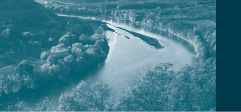Identify natural lands and open space for preservation
Action
States should conduct an inventory of their natural lands and open space to identify those that are most important to protect and those that are best suited for development. Natural lands and open space deliver many important environmental services, including protection of drinking water sources, groundwater recharge, water and air quality protection, stormwater management, natural management of floods, critical wildlife habitat, crop pollinator habitat and carbon sequestration. They also can provide recreation and tourism opportunities, support natural resource-based industries, and play a critical role in shaping regional development patterns. It is also significant that residents place great value on efforts to protect the scenic beauty of the natural areas of their states.
Natural lands often are protected in an uncoordinated and fragmented fashion, however. This can make it difficult to realize the full benefits of preservation and also can reduce the effectiveness of using land preservation to shape growth patterns and direct development to existing communities. A more systematic approach can help focus and coordinate conservation, planning, and investment efforts at the state and local levels to achieve statewide land preservation goals and objectives.
Process
The Department of Natural Resources can pursue a more strategic and systematic approach to land preservation by working with local officials, stakeholders and citizens to identify, prioritize, and map highly valued natural areas and open space that should be targeted for land conservation. Lands targeted for conservation should be identified through a criterion-driven approach. To maximize environmental benefits, emphasis should be placed on defining contiguous corridors and hubs that link or restore high value areas of the natural landscape. The Department of Natural Resources can coordinate available GIS data with departments (e.g. natural resources, transportation, planning, historic resources, and health) to assist in the inventorying effort.
Citizen and stakeholder involvement and support is important in this process and can help build support for subsequent acquisition of lands identified through the inventory process, and for selling the concept of conservation. To build a broad constituency for land preservation, states should develop public involvement, communications, and marketing strategies that target a wide range of interest groups and create a shared vision of what lands to protect. It is important that public officials reach environmental groups, land trusts, hunting and fishing interests, outdoor recreation groups, other natural supporters of land preservation, as well as other stakeholder groups, including potential opponents.
Examples
- Maryland’s Rural Legacy and GreenPrint programs
The Maryland Rural Legacy Program was created in 1997 as the rural counterpart to the urban-focused portion of Maryland’s then-new Smart Growth initiative. The program, designed to protect the state’s remaining "rural legacy," invites willing landowners, private land trusts, and local governments to identify large, contiguous tracts of undeveloped (or relatively undeveloped) land that could be designated for permanent protection. Proposals from various parts of the state then compete against each other for a share of state funds that can be used to purchase development rights on properties within designated Rural Legacy Areas or, in rare circumstances, to purchase the properties outright.
In 2001, the State of Maryland created a companion land preservation program called GreenPrint. It was specifically designed to protect lands critical to the long-term ecological health of the state — the state's "green infrastructure" (See Policy #1, "Adopt a green infrastructure approach to open space, habitat, and water resource programs," in this section). It was based on an extensive, comprehensive inventory of the most ecologically significant lands still remaining in the state. This effort attempted to identify larger "hubs" of environmentally important lands and more linear corridors — so-called "habitat highways" — that connected the hubs. The program identified more than 2 million acres of critical lands in Maryland (nearly one-third of the land mass of the State), of which about 75 percent was unprotected.
— Maryland's GreenPrint Program
— Maryland's Rural Legacy Program - Arizona’s Sonoran Desert Conservation Plan
The Sonoran Desert Conservation Plan, developed under the leadership of the Pima County Board of Supervisors, combined science-based planning with extensive public involvement and education. Information gathered at more than 400 public meetings contributed to the plan, as did a series of educational workshops, a citizens’ steering committee with more than 80 members, and numerous advisory and technical teams. The resulting plan integrates natural resource protection with all county land-use planning.
— Sonoran Desert Conservation Plan


